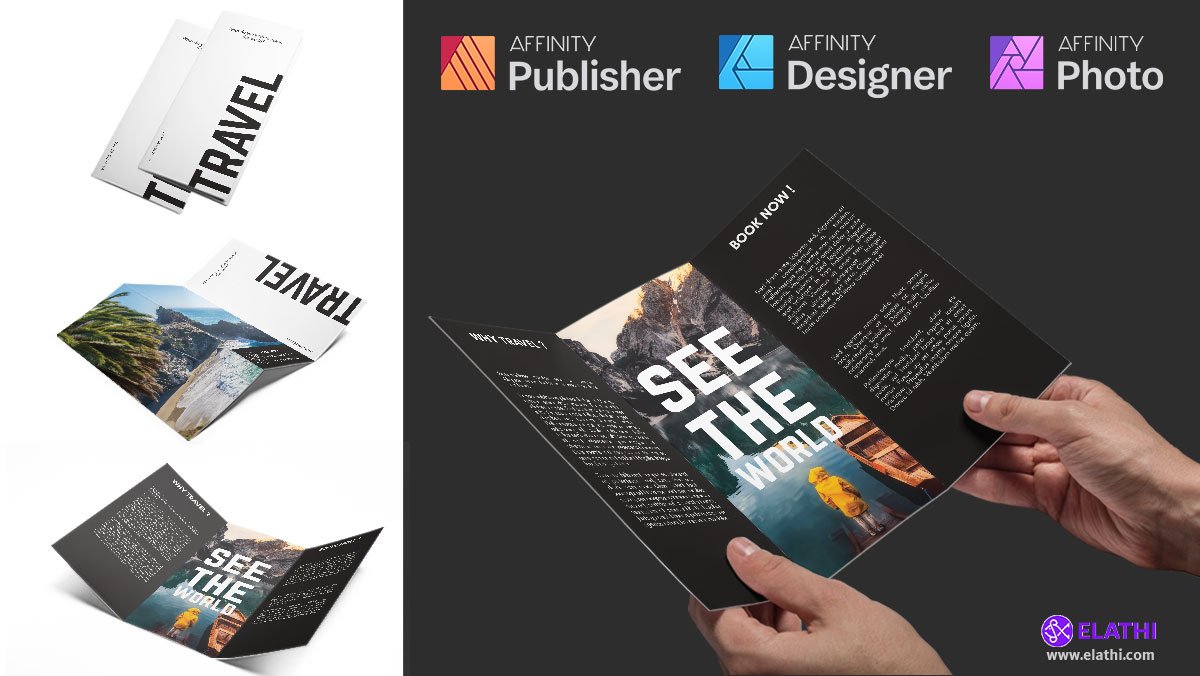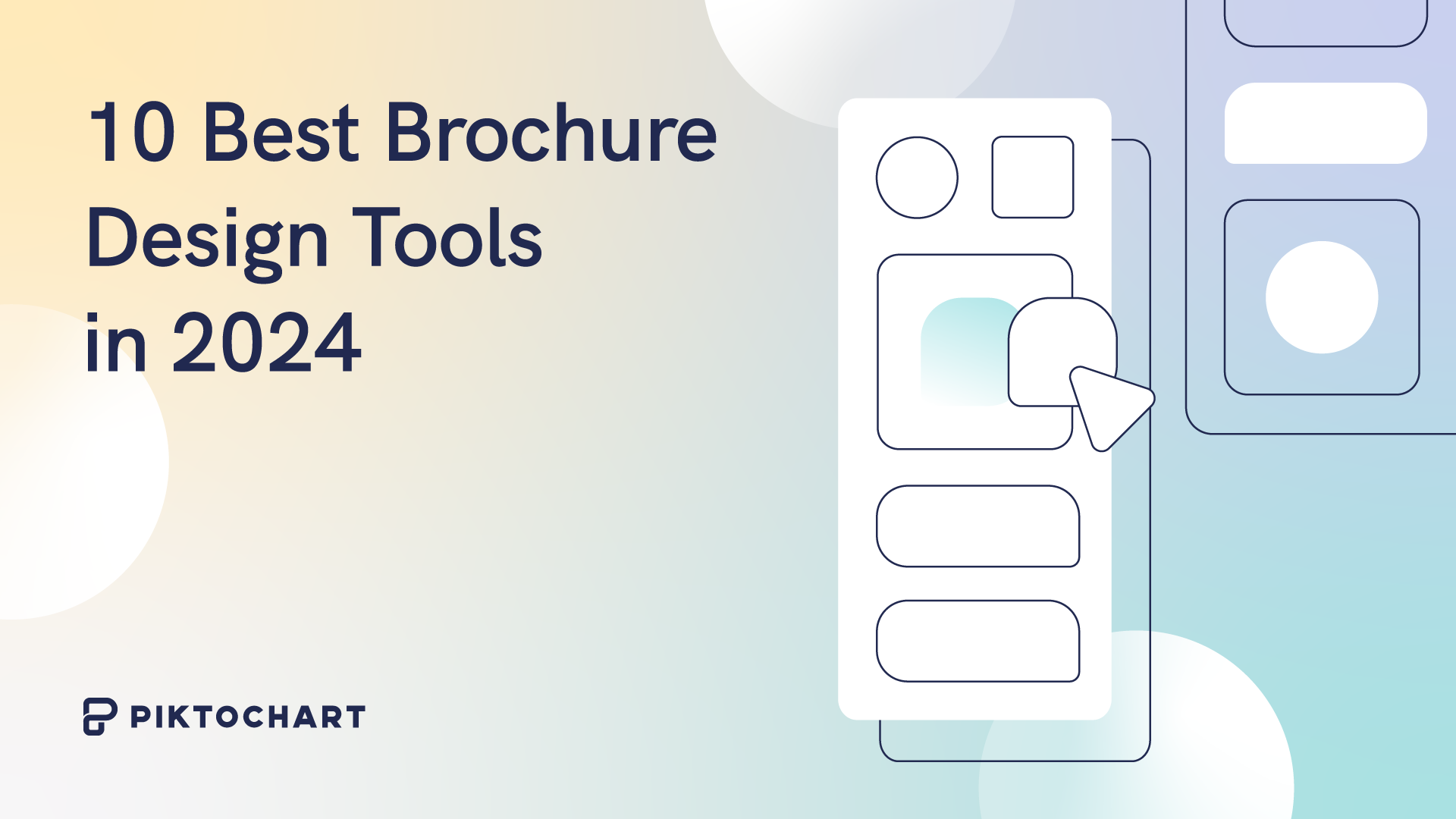In the dynamic world of marketing and design, brochures remain a staple, serving as a vital tool for communication and brand promotion. As you seek to create brochures that not only inform but also captivate, the choice of software can make a significant difference.
Our guide is tailored to help you navigate through various options, each with its unique strengths and features. Whether you’re a seasoned designer or just starting, we’ve got insights on tools that cater to every skill level and need.
From Adobe InDesign’s advanced capabilities to Canva’s user-friendly approach, we explore the top contenders in the market.
Before you move on, consider trying out Piktochart’s AI brochure maker. It’s the quickest way to create a brochure that you can customize to your heart’s content!
With that said, let’s begin our list by looking at Adobe InDesign.
Adobe InDesign
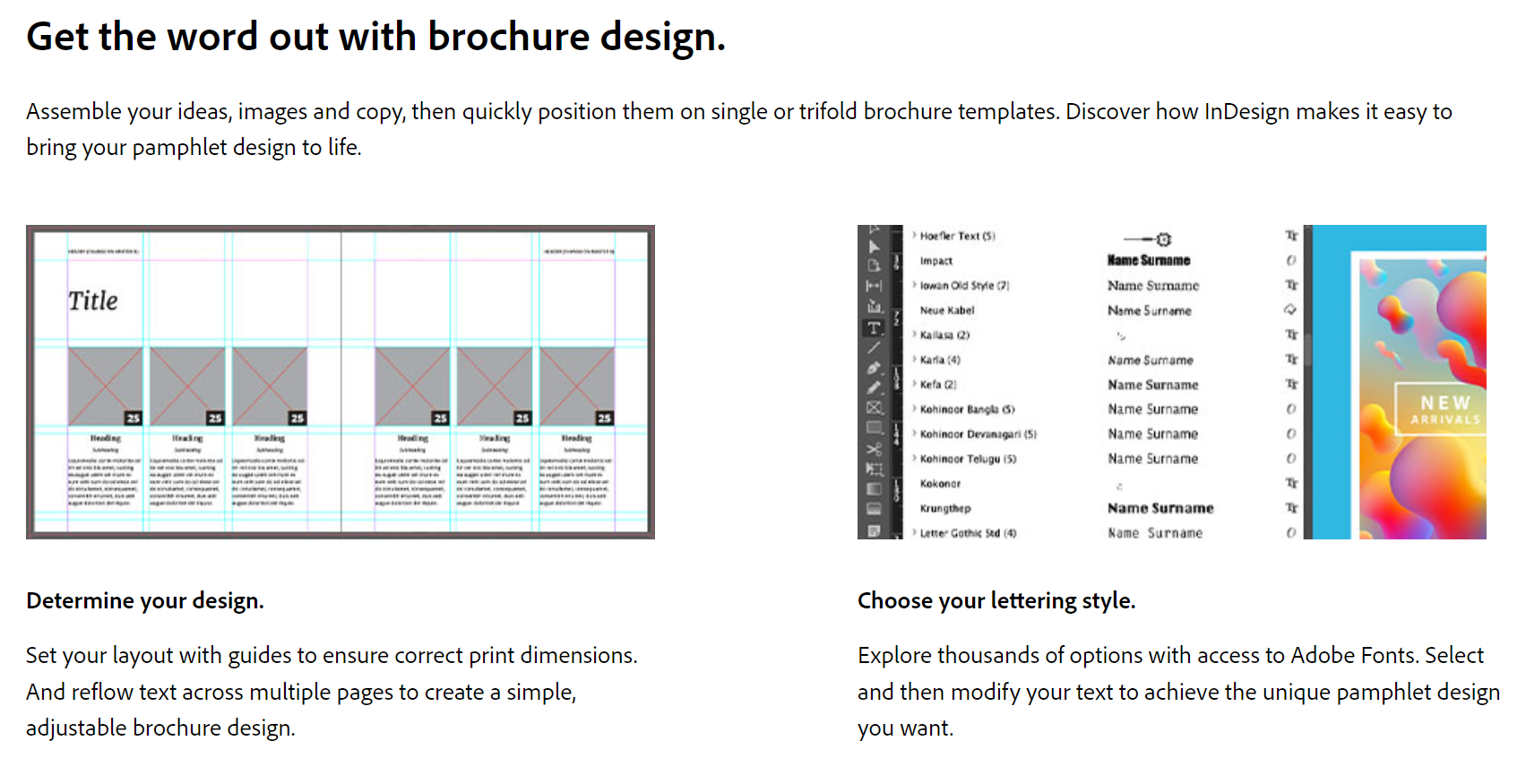
Adobe InDesign is the industry’s leading brochure design software, renowned for its precision and advanced layout capabilities. Part of the Adobe Creative Cloud suite, it’s tailor-made for graphic designers who aim to create professional brochures that stand out. The advanced features of InDesign cater to both desktop publishing and professional print outputs, ensuring high-quality results.
However, there is a steep learning curve that might take some time to master for beginner designers.
While the price is on the higher end, the value you get in return is unmatched, positioning your brochures at the pinnacle of professional design.
Features:
Pricing: $22.99 per month billed annually (Free trial available)
Pros:
- Versatile Layout Options: Flexibility in designing and arranging various elements.
- Professional Typography Tools: Advanced control for high-quality text presentation.
- High-Quality Output: Ensures professional, crisp, and vibrant brochure outputs.
- Master Pages: Great for maintaining consistency across multi-page brochures.
Cons:
- Learning Curve: Can be challenging for beginners due to its complexity.
- Cost: Subscription-based, potentially expensive for individuals or small businesses.
- Resource-Intensive: Requires a computer with good specifications for smooth operation.
- Compatibility and Sharing Issues: Files in proprietary format may pose accessibility challenges.
- Limited Photo Editing and Vector Graphic Tools: Necessitates additional software for certain design tasks.
Canva
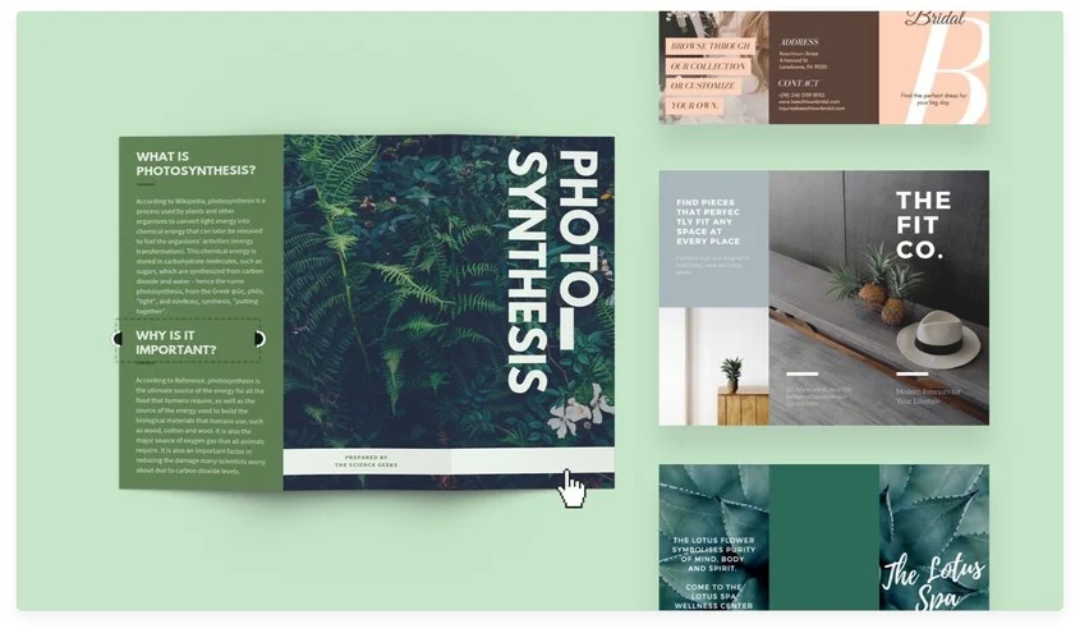
Canva offers a user-friendly interface and a wealth of templates to effortlessly create eye-catching brochures.
This design tool is a go-to for a wide variety of users mainly because of its simplicity. Start from a large library of brochure templates, then quickly edit and customize your design as needed.
If you need more powerful features, such as kerning and tracking, other tools like InDesign will be a better fit for your use case.
Pricing: Forever Free plan, or $9.99 per month for Pro Plan
Pros:
- User-Friendly Interface: Ideal for beginners and non-designers, offering a simple, intuitive design experience.
- Templates and Design Elements: A vast library of templates and design elements that simplify brochure creation.
- Web-Based Platform: Accessible from any device with an internet connection, facilitating easy remote work and collaboration.
- Powerful Forever Free Plan: Offers a free version with numerous features, making it accessible for users with budget constraints.
Cons:
- Limited Customization: While user-friendly, it offers less flexibility compared to professional tools like Adobe InDesign.
- Generic Designs: Due to widespread use of templates, designs may lack uniqueness.
- Lesser Control Over Typography: Limited advanced typography features compared to specialized design software.
Microsoft Publisher
This desktop publishing program offers a suite of built-in templates that streamline the creation process. It also integrates seamlessly with other Microsoft Office software, making it a familiar choice for many marketing and design teams.
With Microsoft Publisher, it’s straightforward to create professional-looking brochures even if you’re not a professional designer. The software boasts a range of editing tools that simplify customizing layouts and fine-tuning designs.
Keep in mind that Publisher is only available for Windows PCs. If Microsoft Office is already part of your tech stack, this option could be a cost-efficienct option.
Pricing: Single license for $159.99 or $10 per month if you subscribe to Microsoft 365 Business Standard Plan.
Pros:
- Ease of Use for Beginners: Intuitive and simpler for those familiar with Microsoft Office suite, making it ideal for beginners.
- Integration with Office Tools: Seamless compatibility with other Microsoft Office applications like Word and Excel.
- Templates and Guided Design: Offers a range of templates and design guides which simplifies the process of creating brochures.
- Cost-Effective: Part of the Microsoft Office suite, it’s a more affordable option compared to subscription-based software.
- Good for Print Projects: Well-suited for creating print-oriented materials like brochures, with features tailored for print layouts.
Cons:
- Limited Design Capabilities: Lacks the advanced design features and flexibility found in specialized design software like Adobe InDesign.
- Limited Output Options: You can only export in PDF or XPS formats.
- Windows-Centric: Sorry Mac users, there are other choices available to you (unless you run the program from Boot Camp).
Marq
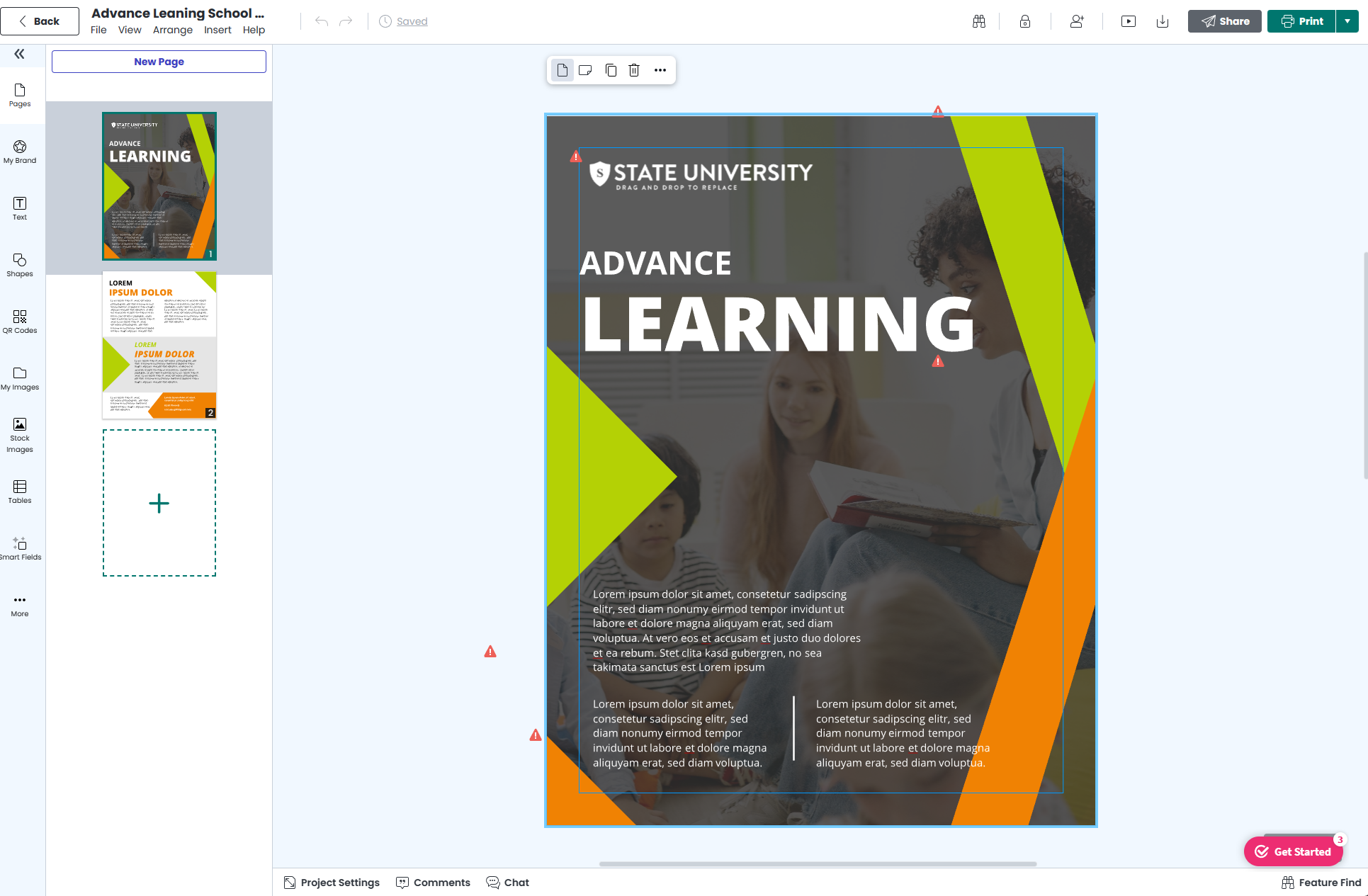
Previously known as LucidPress, Marq offers a collaborative, web-based design platform that lets you create professional brochures with real-time team input.
Using the tool is straightforward and requires minimal design experience thanks to the brochure design templates and easy drag-and-drop interface.
Marq’s strengths lie in the real-time edits and ability to leave feedback for other team members. If you work in a team where designs go through rounds of edits before publishing, this is a good option as a brochure design software.
Pricing: From $10 per month
Pros:
- Cloud-Based: Easy access from any device with an internet connection, facilitating collaboration and remote work.
- Real-Time Collaboration: Enables multiple users to work on a document simultaneously.
- User-Friendly Interface: Intuitive design ideal for beginners and non-design professionals.
- Templates and Brand Management: Offers a variety of templates and features for consistent brand management across designs.
Cons:
- Limited Features: May lack some of the advanced design capabilities of software like InDesign.
- Limited Offline Functionality: Less effective when working without an internet connection.
- Template Reliance: Heavy reliance on templates could limit design uniqueness.
QuarkXPress
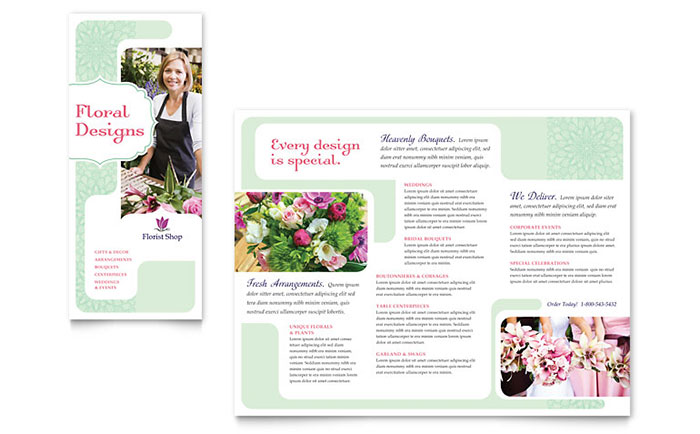
QuarkXPress has been around for a while and was considered the industry standard for print design layout software.
Although Adobe InDesign has since claimed that title, QuarkXPress still offers a robust set of tools for professional brochure design.
Quark is a WYSIWYG (what you see is what you get) editor, meaning how the content appears is exactly what gets printed. This makes your life simpler when editing your work since you don’t have to second guess the output.
This tool is a good option as a standalone design tool, as it is built to be full-stack. That means content creation and workflow automation can be set up in Quark, unlike InDesign which requires proprietary software and plugins to function at the same level.
Unlike other desktop publishing software, QuarkXPress integrates vector graphic design capabilities, streamlining your brochure design workflow. This professional tool ensures you can craft stunning brochures that people are more likely to read.
Using the tool usually costs $259 per year, or $699 for a one-time license. However, students or teachers can access QuarkXPress at a much more affordable pricing point, at $89 per year or $5 per license (minimum of 100 licenses).
Pricing: Standard prices – $259 per year or $699 for one-time license
- Academic licenses available at $89 per year or $5 per license (minimum of 100 licenses)
Pros:
- Typography Control: Excellent typography tools for professional-looking text layouts.
- Print and Digital Publishing: Suitable for both print and digital media designs.
- Affordable pricing: For standard users, option for one-time purchase. Academic pricing among cheapest we’ve seen on the market.
- Flex Layouts: Specialized features for web and responsive design.
Cons:
- Steep Learning Curve: Can be challenging to learn for beginners.
- Fewer Integration Options: Doesn’t integrate with collaborative platforms
- Less Intuitive Interface: The interface may feel less modern and intuitive compared to competitors.
- Limited Installation Options: You can only use QuarkXPress on machine.
Adobe Express: Best for freelancers

We’ve recommended Adobe Express in other guides, and for good reason: it’s a solid option for all-round design. It’s as user-friendly as Canva, but has professional-level features that other software tools don’t offer.
Formerly known as Adobe Spark, Adobe Express is part of the Creative Cloud suite. As a cloud-based tool, you can access Express on any device.
It comes with a wide range of templates to use and a user-friendly interface. The free plan is generous with its features, such as the background removal tool.
The pricing is very affordable for a solopreneur or designer working on their own.
Pricing: Forever Free plan or the Premium Plan at $9.99 per month
Pros:
- Easy to Use: Intuitive and simple, great for beginners and quick designs.
- Integration with Adobe Products: Easily integrates with other Adobe products and services.
- Better Export Options: Adobe Express exports in unflattented PDFs, meaning you can edit the PDF with its different layers in another program.
- Templates: Wide range of templates that cater to various design needs.
- Cross-Platform Functionality: Available on web and mobile platforms.
- Free and Paid Versions: Accessible with both free and premium options.
Cons:
- Template-Dependent: Heavily reliant on templates, which may limit creativity.
- Web-based Only Tool: Unlike other tools like Canva or Inkscape, you can only use Adobe Express via a browser and internet connection.
- Performance Issues: Sometimes can feel laggy.
Inkscape: Best offline design tool
As one of the best brochure design software, Inkscape is packed with all the tools necessary for both experienced or professional designers. From the initial planning stage to the final touches, Inkscape provides the same features you’d expect from high-end software, without the hefty price tag. In fact, Inkscape is entirely free.
It’s an open-source software that’s programmed entirely by volunteers as a labor of love. Known for its ability to create vector graphics, Inkscape is often compared to Adobe Illustrator due to having many overlapping features.
Inkscape works on Windows, Mac OS, and Linux, unlike Illustrator, which only works on the former two operating systems.
For free software, it covers most of the bases that non-designers will need. Inkscape supports RGB color, lets you save in a variety of file formats, and has many of the editing features that Illustrator has.
Pricing: Free to download and use.
Pros:
- Free and Open Source: No cost to use, which is great for users on a budget.
- Vector Graphic Focus: Excellent for creating vector graphics, which are scalable without losing quality.
- Cross-Platform: Available on multiple operating systems including Windows, Mac, and Linux.
- Community Support: Benefits from a supportive and active user community for help and resources.
Cons:
- No CMYK Color Mode: This is more ideal for print format than RGB.
- Fewer Integrations Than Other Tools: Might impact the scope of your work if you need more than what Inkscape offers.
- Limited Preview Option: Can be a bit hard to see what the output will be like.
Affinity Designer: Best for real-time editing
Affinity Designer is a great pick for those new to designing brochures, offering an easier alternative to Adobe Illustrator. It’s especially good for beginners, but with its many features, it might take a bit of time to get used to.
One of the best parts of Affinity Designer is the Vector Brush Tool. This tool lets you play around with different stroke styles, perfect for getting those intricate designs just right.
Perhaps Affinity’s strongest plus is the real-time editing. This means that if you’re working in a team, everyone can see changes as they happen.
Plus, if you’re watching your budget, Affinity Designer provides all the necessary tools for creating brochures without a hefty price tag.
Just a heads-up, though – there aren’t as many how-to guides for Affinity Designer compared to Adobe, so becoming fluent with this tool might take a bit more effort.
Pricing: One-off payment for $69.99 for macOS or Windows as a one-off payment, excluding tax. For iPad users, it’s available at $18.49.
Pros:
- Professional-Level Features: Offers robust tools suitable for high-quality graphic design.
- Vector and Raster Design: Supports both vector and raster graphics within the same application.
- Intuitive Interface: User-friendly interface that professionals and hobbyists alike can navigate.
Cons:
- Learning Curve: Might be challenging for complete beginners to grasp all features.
- Limited Plugin Ecosystem: Fewer third-party plugins compared to established software like Adobe.
- No Free Version: Lacks a free version, which might be a barrier for some users.
Swift Publisher: Best for Mac OS users
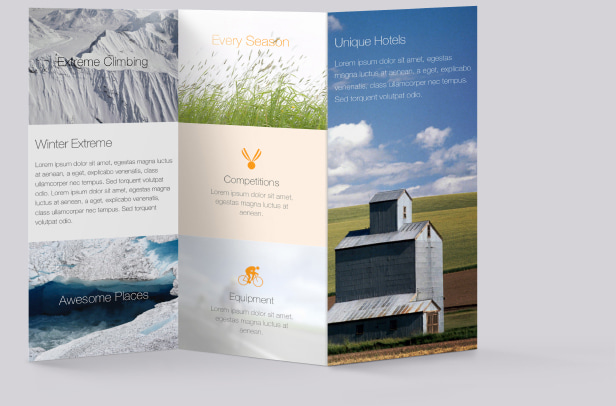
If you read about Microsoft Publisher and felt some FOMO, worry not. Swift Publisher is a solid replacement for Mac users looking for dedicated software to create print materials like brochures.
It’s packed with all the features you’d expect in an easy-to-use design tool, making it a breeze for anyone to start designing right away. Think of it as similar to Affinity Designer, but tailored specifically for Mac.
One of the key features of Swift Publisher is its support for CMYK color mode. This is really important for printing, as it ensures that the colors in your brochures come out looking just as you intended when they’re printed. This feature is a big plus for anyone planning to print their designs professionally.
Pricing: Single user license (prices start from $19.99
Pros:
- Mac Optimization: Swift Publisher is specifically designed for macOS.
- CMYK Color Mode Support: Ensures color accuracy and quality in the final printed product.
- User-Friendly Interface: Swift Publisher is known for its intuitive and straightforward interface, making it accessible for users of all skill levels.
Cons:
- Less Advanced Graphic Design Features: May lack some advanced graphic design functionalities compared to tools like InDesign.
- Limited Web and Digital Publishing Features: The tool primarily focuses on print design.
- Lesser Third-Party Integrations: Swift Publisher might not offer as many integrations with third-party applications and services as some of its competitors.
Piktochart: Best all-round brochure maker
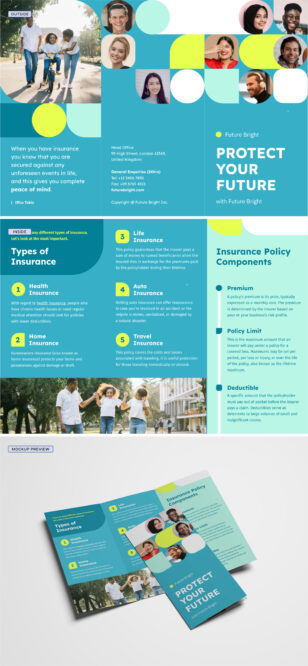
Probably expected but we had to mention our tool! Piktochart is a user-friendly choice to create brochures, especially if you value simplicity and speed. And you don’t have to start from a blank canvas. With an extensive library of professional templates made by designers, Piktochart takes the guesswork out of design, offering a variety of styles to kickstart your project to create stunning brochures.
The integrated brand assets feature ensures that your brochures align with your brand’s aesthetic, maintaining consistency across all your materials.
Pricing: Forever free plan, $14 per month billed annually, or $39 per year for Academic licenses
Pros:
- Intuitive User Interface: User-friendly interface makes it exceptionally easy for beginners and non-designers to navigate and create brochures.
- Rich Template Library: Offers a vast selection of brochure design templates, catering to various styles and themes.
- Integrated Brand Assets: Easily incorporate brand elements such as logos, color schemes, and fonts, ensuring brand consistency across all brochure designs.
- Effective Drag-and-Drop Editor: Streamlines the design process, enabling quick arrangement of elements, effortless customization of layouts, and hassle-free insertion of images and text.
Cons:
- Primarily for Digital Formats: Piktochart is more focused on digital design, which might mean its features are not as optimized for print layouts, potentially affecting the quality of printed brochures.
- Limited Photo Editing Tools: The platform may not offer extensive photo editing capabilities comapred to more advanced tools like InDesign.
Importance of Quality Brochure Design
In today’s competitive market, having a professionally designed brochure can make all the difference in capturing your audience’s attention. A quality brochure serves as a tangible representation of your brand, ensuring that your message resonates with potential clients or customers.
First Impressions Matter
– Visually appealing graphics
– Professional layout and typography
– Consistent branding throughout
Your brochure’s design influences how your business is perceived. If it looks sleek and modern, you’re more likely to be seen as a credible and trustworthy company. On the other hand, a poorly designed brochure might turn potential interest into skepticism.
Invest in a quality design tool to ensure your brochures help, rather than hinder, your marketing efforts.
Are brochures still effective?
Despite the digital age’s dominance, you’ll find that the tangibility of brochures still holds significant sway in marketing effectiveness. They offer a physical connection that digital ads can’t match, engaging multiple senses to make a lasting impression. When you hand out a well-designed brochure, you provide potential customers with a piece they can touch, feel, and even take home. It’s this physical presence that helps reinforce your brand and message.
Moreover, brochures have a versatility that’s hard to beat. They’re perfect for leaving at strategic locations, handing out at events, or mailing directly to prospects. This enduring marketing tool can complement your digital strategy beautifully, ensuring you cover all bases in reaching your audience.
Conclusion
You’ve explored the top brochure design tools of 2024, from Piktochart’s ease to Adobe InDesign’s prowess and Canva’s user-friendliness.
Remember, compelling brochures can still captivate your audience. When picking software, consider usability, features, and cost.
Now, armed with the right tool, unleash your creativity and craft brochures that don’t just share information—they tell a memorable story.
It’s time to elevate your brand and make a lasting impression. Get designing!
Frequently Asked Questions
How Do Environmental Considerations Impact the Choice of Brochure Design Software?
You’ll want software that supports sustainable design practices, like digital sharing to reduce print materials, and one that encourages the use of eco-friendly fonts and colors to minimize ink usage.
Can Brochure Design Software Accommodate Accessibility Features for Visually Impaired or Dyslexic Readers?
Yes, you can find brochure design software that includes accessibility features to aid visually impaired or dyslexic readers, such as alt text for images and readable font options.
What Are the Data Security Implications When Using Cloud-Based Brochure Design Software?
When you use cloud-based brochure design software, your data’s security depends on the provider’s encryption and privacy policies. Always check their terms and safeguard your designs with strong passwords.
How Does Brochure Design Software Handle the Integration of Augmented Reality (Ar) Elements?
You’ll find that modern brochure design software easily incorporates AR elements, allowing you to create interactive experiences that leap off the page and engage your audience in a dynamic way.
Are There Any Brochure Design Software Options That Support Real-Time Collaboration Across Different Geographical Locations?
You’ll find that software like Canva and Adobe Creative Cloud offer real-time collaboration features, allowing teams to work together seamlessly from any location.
